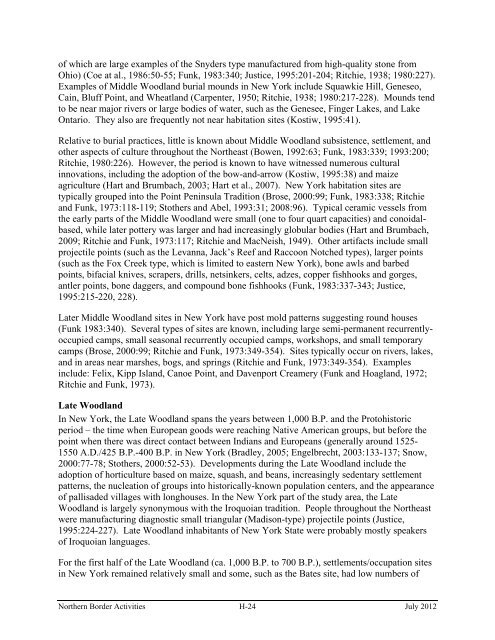Appendix H - Historical Archaeological and ... - CBP.gov
Appendix H - Historical Archaeological and ... - CBP.gov
Appendix H - Historical Archaeological and ... - CBP.gov
You also want an ePaper? Increase the reach of your titles
YUMPU automatically turns print PDFs into web optimized ePapers that Google loves.
of which are large examples of the Snyders type manufactured from high-quality stone from<br />
Ohio) (Coe at al., 1986:50-55; Funk, 1983:340; Justice, 1995:201-204; Ritchie, 1938; 1980:227).<br />
Examples of Middle Woodl<strong>and</strong> burial mounds in New York include Squawkie Hill, Geneseo,<br />
Cain, Bluff Point, <strong>and</strong> Wheatl<strong>and</strong> (Carpenter, 1950; Ritchie, 1938; 1980:217-228). Mounds tend<br />
to be near major rivers or large bodies of water, such as the Genesee, Finger Lakes, <strong>and</strong> Lake<br />
Ontario. They also are frequently not near habitation sites (Kostiw, 1995:41).<br />
Relative to burial practices, little is known about Middle Woodl<strong>and</strong> subsistence, settlement, <strong>and</strong><br />
other aspects of culture throughout the Northeast (Bowen, 1992:63; Funk, 1983:339; 1993:200;<br />
Ritchie, 1980:226). However, the period is known to have witnessed numerous cultural<br />
innovations, including the adoption of the bow-<strong>and</strong>-arrow (Kostiw, 1995:38) <strong>and</strong> maize<br />
agriculture (Hart <strong>and</strong> Brumbach, 2003; Hart et al., 2007). New York habitation sites are<br />
typically grouped into the Point Peninsula Tradition (Brose, 2000:99; Funk, 1983:338; Ritchie<br />
<strong>and</strong> Funk, 1973:118-119; Stothers <strong>and</strong> Abel, 1993:31; 2008:96). Typical ceramic vessels from<br />
the early parts of the Middle Woodl<strong>and</strong> were small (one to four quart capacities) <strong>and</strong> conoidalbased,<br />
while later pottery was larger <strong>and</strong> had increasingly globular bodies (Hart <strong>and</strong> Brumbach,<br />
2009; Ritchie <strong>and</strong> Funk, 1973:117; Ritchie <strong>and</strong> MacNeish, 1949). Other artifacts include small<br />
projectile points (such as the Levanna, Jack’s Reef <strong>and</strong> Raccoon Notched types), larger points<br />
(such as the Fox Creek type, which is limited to eastern New York), bone awls <strong>and</strong> barbed<br />
points, bifacial knives, scrapers, drills, netsinkers, celts, adzes, copper fishhooks <strong>and</strong> gorges,<br />
antler points, bone daggers, <strong>and</strong> compound bone fishhooks (Funk, 1983:337-343; Justice,<br />
1995:215-220, 228).<br />
Later Middle Woodl<strong>and</strong> sites in New York have post mold patterns suggesting round houses<br />
(Funk 1983:340). Several types of sites are known, including large semi-permanent recurrentlyoccupied<br />
camps, small seasonal recurrently occupied camps, workshops, <strong>and</strong> small temporary<br />
camps (Brose, 2000:99; Ritchie <strong>and</strong> Funk, 1973:349-354). Sites typically occur on rivers, lakes,<br />
<strong>and</strong> in areas near marshes, bogs, <strong>and</strong> springs (Ritchie <strong>and</strong> Funk, 1973:349-354). Examples<br />
include: Felix, Kipp Isl<strong>and</strong>, Canoe Point, <strong>and</strong> Davenport Creamery (Funk <strong>and</strong> Hoagl<strong>and</strong>, 1972;<br />
Ritchie <strong>and</strong> Funk, 1973).<br />
Late Woodl<strong>and</strong><br />
In New York, the Late Woodl<strong>and</strong> spans the years between 1,000 B.P. <strong>and</strong> the Protohistoric<br />
period – the time when European goods were reaching Native American groups, but before the<br />
point when there was direct contact between Indians <strong>and</strong> Europeans (generally around 1525-<br />
1550 A.D./425 B.P.-400 B.P. in New York (Bradley, 2005; Engelbrecht, 2003:133-137; Snow,<br />
2000:77-78; Stothers, 2000:52-53). Developments during the Late Woodl<strong>and</strong> include the<br />
adoption of horticulture based on maize, squash, <strong>and</strong> beans, increasingly sedentary settlement<br />
patterns, the nucleation of groups into historically-known population centers, <strong>and</strong> the appearance<br />
of pallisaded villages with longhouses. In the New York part of the study area, the Late<br />
Woodl<strong>and</strong> is largely synonymous with the Iroquoian tradition. People throughout the Northeast<br />
were manufacturing diagnostic small triangular (Madison-type) projectile points (Justice,<br />
1995:224-227). Late Woodl<strong>and</strong> inhabitants of New York State were probably mostly speakers<br />
of Iroquoian languages.<br />
For the first half of the Late Woodl<strong>and</strong> (ca. 1,000 B.P. to 700 B.P.), settlements/occupation sites<br />
in New York remained relatively small <strong>and</strong> some, such as the Bates site, had low numbers of<br />
Northern Border Activities H-24 July 2012
















